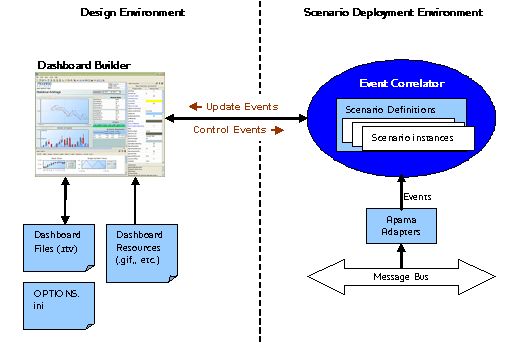About dashboards
Dashboards provide the ability to view and interact with scenarios and DataViews. They contain charts and other objects that dynamically visualize the values of scenario variables and DataView fields. Dashboards can also contain control objects for creating, editing, and deleting scenario instances and DataView items.
An Apama project typically uses of one or more dashboards. Each dashboard defines a single display, or view, of information. Dashboards are created in the Dashboard Builder (or with the Dashboard Generation Wizard—see Using Apama Studio). Each dashboard is stored in a separate .rtv file. All .rtv files for a given project are stored in a single directory. This directory also contains a .dashboard file, which records various dashboard parameters, including the file that is to be used as the dashboard project’s main dashboard.
The contents of a dashboard, the charts displayed and the data shown, is determined when the dashboard is created in the Builder. The Dashboard Viewer provides the ability to use dashboards created in the Builder. Dashboards can also be deployed as simple Web pages, applets, or WebStart applications.
Deployed dashboards connect to one or more correlators via a Dashboard Data Server or Display Server. As the scenarios in a correlator run and their variables change, or as a DataView item’s fields are updated, update events are sent to all connected dashboards. When a dashboard receives an update event, it updates its display in real time to show the behavior of the scenarios or DataViews. User interactions with the dashboard, such as creating an instance of a scenario, result in control events being sent via the Data Server or Display Server to the correlator.
Dashboard Builder communicates with running correlators so that you can see at design time what a dashboard will look like when deployed. Unlike a deployed dashboard, the Builder connects directly to the correlators it communicates with. The following diagram illustrates the design environment for dashboards:
Dashboard-correlator communication in the development environment
In order to use Dashboard Builder to create a dashboard for a scenario or DataView, you need to start a correlator and inject the scenario or DataView into it. You should use a development correlator to initially develop dashboards, not a deployed correlator acting on live data.
Dashboard Builder does not support creating dashboards for scenarios or DataViews that have not been injected into a correlator.

